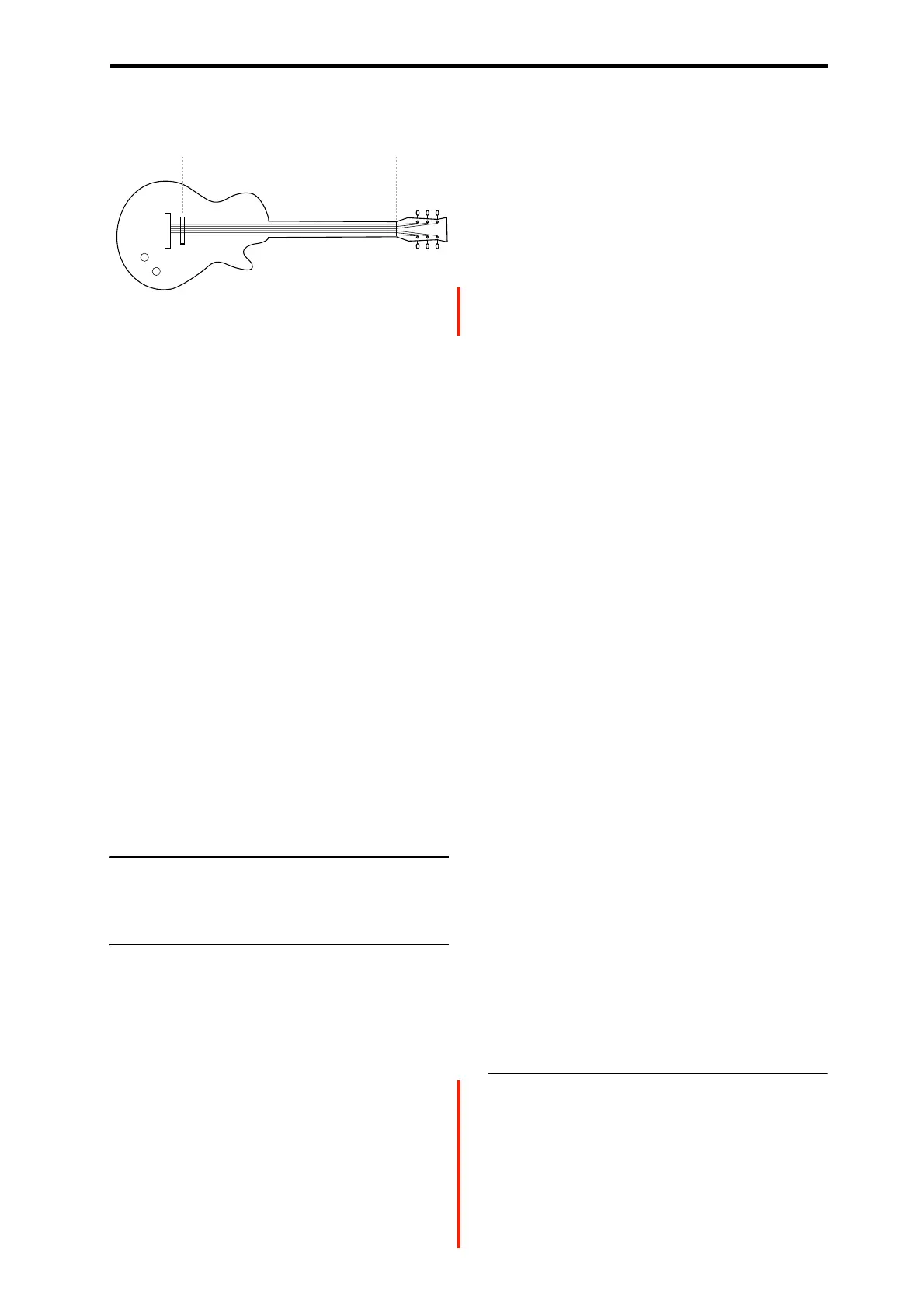PROGRAM > STR-1: String 4–8: Pickups/Feedback
231
Pickup Position
AMS [List of AMS Sources]
This selects a modulation source to control the Position. Try
using an LFO, for instance. For a list of AMS sources, see
“Alternate Modulation Source (AMS) List” on page 901.
Intensity [-100.0…+100.0]
This controls the depth and direction of the Position AMS
modulation.
Tracking Mode [String Track, Keyboard, Off]
This controls the relationship between the pickup Position
and the pitch.
String Track scales the pickup position according to the
current String, as set in the String Tracking section.
Keyboard scales the pickup position according to pitch,
without taking the String settings into account. This might be
more appropriate for clav sounds, for instance.
Off disables pitch-related scaling. This setting works well
when sweeping the position via AMS (such as by an LFO)
for chorusing effects, as described below.
Creating “chorusing” with the pickups
For a chorus-like effect, set the pickup Tracking Mode to
Off, and modulate the pickup position with an LFO. With
the pickup Tracking Mode set to Keyboard, the modulation
depth varies with note, so that the depth is large on the low
end of the keyboard and small at the top. With the pickup
Tracking Mode set to String, the depth will step to a new
value at each open string.
4–8b: Pickup 2
This is the second pickup. It has the same parameters as
Pickup 1, above.
4–8c: Feedback
This lets you route audio from elsewhere in NAUTILUS
through the string. You can use any of the audio inputs, any
of the audio outputs, the REC buses, the FX Control buses,
or the outputs of any of the Insert, Master, or Total Effects.
The main purpose of this is to process the STR-1 through
one or more Insert Effects, such as an overdrive or amp
model, and then send that audio back into the STR-1, for
traditional electric guitar feedback effects.
All three feedback parameters–Distance, Orientation, and
Level–can be modulated in real-time. You can use this to
model the classic effect of holding an electric guitar near an
amp until it feeds back, and then varying the pitch of the
feedback by changing the guitar’s orientation in relation to,
and distance from, the amp.
You can also route live or recorded audio through the string
an/or filters, in realtime–and we’re sure that you’ll be able to
think of other creative uses!
Source and Channel
The feedback source and channel (left, right, or L+R
summation) are selected by the Input Source and Channel
parameters in the current Program, Combination Timbre, or
Song Track.
For more information, see “4–2: EXi Audio Input” on
page 134 (PROGRAM mode), “2–6: EXi Audio Input” on
page 412 (COMBINATION mode), and “2–6: EXi Audio
Input” on page 487 (SEQUENCER mode).
Distance (meters) [0.23…10.00]
This models the distance of the guitar from the amp. Usually,
it’s best to set this very low, but higher settings may produce
interesting effects.
AMS [List of AMS Sources]
This selects a modulation source to control the Distance. For
a list of AMS sources, see “Alternate Modulation Source
(AMS) List” on page 901.
Intensity [-10.00…+10.00]
This controls the depth and direction of the Distance AMS
modulation.
Orientation (degrees) [-180…+180]
This models turning the guitar away from the amp. Turning
the guitar primarily affects the tone of the feedback, but also
affects the pitch and the volume.
AMS [List of AMS Sources]
This selects a modulation source to control the Orientation.
For a list of AMS sources, see “Alternate Modulation Source
(AMS) List” on page 901.
Intensity [-180…+180]
This controls the depth and direction of the Orientation
AMS modulation.
Level [0…100]
This controls the overall gain of the feedback into the string.
Unlike the other feedback parameters, this can be different
for each voice.
AMS [List of AMS Sources]
This selects a modulation source to control the Level. For a
list of AMS sources, see “Alternate Modulation Source
(AMS) List” on page 901.
Intensity [-100…+100]
This controls the depth and direction of the Level AMS
modulation.
v
4–8: Page Menu Commands
• Compare →p.112
• Write Program →p.112
• Exclusive Solo →p.113
•PAGE →p.126
•MODE →p.126
Position = 0.0 Position = 100.0

